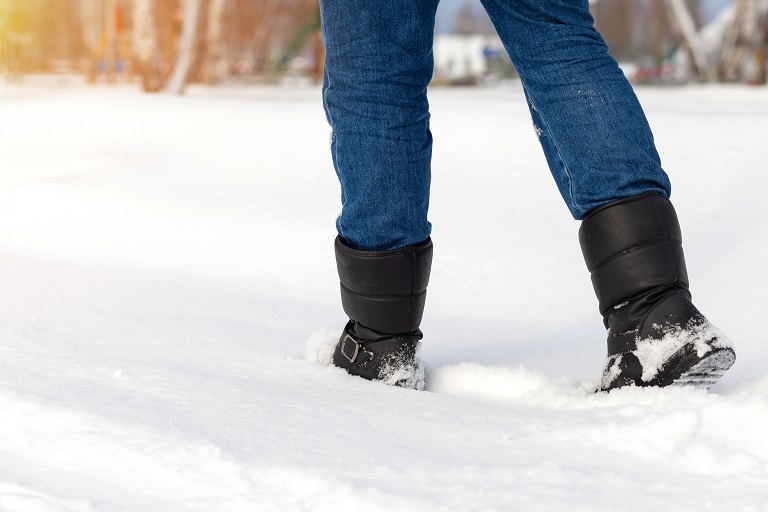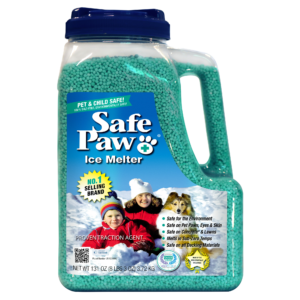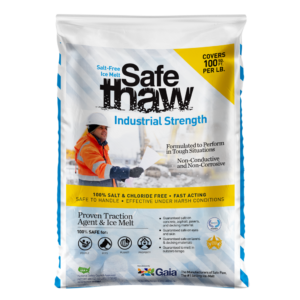3 Things You Must Know About Shoe Spikes Before Walking On Ice

Traction devices are removable components that go over your running shoes to provide more traction while jogging in the winter, whether on snow or ice. Metal teeth, spikes, tips, or, in one case, coiled wire are the active components of traction devices. But can you walk in them freely, without worrying about damaging indoor surfaces? Even though they help you walk on snow and ice, they are not the best option available.
The best safety aid to walk on ice is a natural and instant traction agent. So, let us know more about shoe spikes and the best way to walk on ice.
A Safer Way To Walk On Ice
Navigating icy terrains necessitates certain precautions and techniques. Here’s how you can walk on ice more safely:
- Penguin Walk: Leaning forward slightly and keeping your center of gravity over your front foot can help prevent slips.
- Small Steps: Taking short, shuffle-like steps can help maintain balance and control.
- Appropriate Footwear: Shoes with non-slip soles can provide better traction.
- Use Handrails: Make use of any available handrails or supports.
In addition to these techniques, traction agents are making the task simpler. One such agent, ‘Walk On Ice,’ offers an eco-friendly and chemical-free solution that provides instant grip on icy surfaces.
Best Shoes To Walk On Ice
While shoes with non-slip soles and well-defined treads are helpful, combining them with a reliable traction agent like ‘Walk On Ice’ can offer even better results. By providing immediate traction, ‘Walk On Ice’ enhances the performance of your footwear, ensuring you can walk confidently even on the iciest surfaces.
As we continue to confront icy conditions, whether it’s the result of a winter storm or an everyday occurrence in colder climates, it’s reassuring to know that options like ‘Walk On Ice’ are available. When paired with the right footwear and careful walking techniques, we can indeed walk on ice without slipping, making winter navigation a more manageable and safer task.
3 Things To Know About Shoe Spikes Before Walking On Ice
Select a suitable pair of shoe spikes. Look for qualities like well-insulated, waterproof, thick non-slip tread sole made of natural rubber, wide low heels, and lightweight for warmth and stability in your spike shoes for winters.
Walking on hard-packed snow and ice can be made easier with ice grippers on your shoes. But be cautious! When walking on smooth surfaces like stone, tile, or ceramic, grippers become slippery and must be removed. Before you buy the grippers, make sure you can attach and detach them from your boots.
Before you start driving in winters, remove the spikes the same way you remove them before entering your house. They make your winter driving difficult and cause discomfort while driving.
Walking On Ice Safety Tips
- Wear a warm hat, scarf, and mittens or gloves to keep your body warm. Layering your clothing might also help you stay warm.
- Clear snow and other hazards from entranceways and walkways. It will help you to maintain a safe walking space.
- Carry a small can of traction agent in your jacket pocket or handbag to sprinkle on frozen walkways, steps, bus stops, and other surfaces.
- On ice sidewalks and parking lots, proceed with caution. Look up to observe where the next slippery places are and keep an eye out for any approaching vehicles.
- When walking in slippery or snowy conditions, avoid listening to music or conversing on the phone. You must be able to hear incoming vehicles or other background noises.
- Even though the pavement appears to be wet, there could be black ice, so proceed with caution. Early in the mornings, ice is more likely to occur, so be cautious.
- When descending stairs, go gently and deliberately. Make sure your feet are planted firmly on each step and that you have a solid grasp on the handrail.
- Check the entry and try not to step on any rugs in the doors because the flooring of buildings may be covered in melted snow and ice.
- Because snow and ice clearance is less likely on a shortcut path, it may be risky.
Get ready for winter with Walk On Ice instant traction on snow and ice
Conclusion
When you are deciding on safety aid to walk on the ice this winter, opt for a can of chemical-free and instant traction agent. Just spread it before walking on the ice and get the magical red-carpet effect.
FAQs
Other Ice Melt Products
Safe Paw
The Original and the #1 Pet and Child Safe Ice Melt for over 20 years. Guaranteed environmentally safe – will not harm waterways and sensitive wetlands. Safe Paw can change how winter affects our planet.

Safe Thaw
Imagine an ice melt you can put down and never worry about. It won’t harm pets, kids and your property. That’s Safe Thaw. Unlike anything else on the market, Safe Thaw can change how winter affects our planet.



